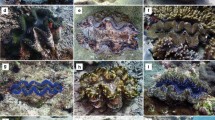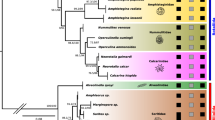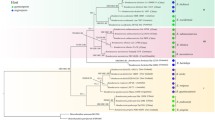Abstract
There is accumulating evidence that the general shape of the ribosomal DNA-based phylogeny of Eukaryotes is strongly biased by the long-branch attraction phenomenon, leading to an artifactual basal clustering of groups that are probably highly derived. Among these groups, Foraminifera are of particular interest, because their deep phylogenetic position in ribosomal trees contrasts with their Cambrian appearance in the fossil record. A recent actin-based phylogeny of Eukaryotes has proposed that Foraminifera might be closely related to Cercozoa and, thus, branch among the so-called crown of Eukaryotes. Here, we reanalyze the small-subunit ribosomal RNA gene (SSU rDNA) phylogeny by removing all long-branching lineages that could artifactually attract foraminiferan sequences to the base of the tree. Our analyses reveal that Foraminifera branch together with the marine testate filosean Gromia oviformis as a sister group to Cercozoa, in agreement with actin phylogeny. Our study confirms the utility of SSU rDNA as a phylogenetic marker of megaevolutionary history, provided that the artifacts due to the heterogeneity of substitution rates in ribosomal genes are circumvented.
Similar content being viewed by others
References
MS Atkins AP Teske OR Anderson (2000) ArticleTitleA survey of flagellate diversity at four deep-sea hydrothermal vents in the eastern Pacific ocean using structural and molecular approaches. J Eukaryot Microbiol 47 400–411 Occurrence Handle1:CAS:528:DC%2BD3cXlvVKrtr0%3D Occurrence Handle11140455
SL Baldauf AJ Roger I Wenk-Siefert WF Doolittle (2000) ArticleTitleA kingdom level phylogeny of Eukaryotes based on combined protein data. Science 290 972–977 Occurrence Handle10.1126/science.290.5493.972 Occurrence Handle1:CAS:528:DC%2BD3cXnvVWksL0%3D Occurrence Handle11062127
D Bhattacharya T Helmchen M Melkonian (1995) ArticleTitleMolecular evolutionary analyses of nuclear-encoded small subunit ribosomal RNA identify an independent rhizopod lineage containing the Euglyphina and the Chlorarachniophyta. J Eukaryot Microbiol 42 65–69 Occurrence Handle1:CAS:528:DyaK2MXlsVeqtL4%3D
I Bolivar JF Fahrni A Smirnov J Pawlowski (2001) ArticleTitleSSU rRNA-based phylogenetic position of the genera Amoeba and Chaos (Lobosea, Gymnamoebia): The origin of Gymnamoebae revisited. Mol Biol Evol 18 2306–2314 Occurrence Handle1:CAS:528:DC%2BD3MXptFGkur8%3D Occurrence Handle11719580
SR Bulman SF Kühn JW Marshall E Schnepf (2001) ArticleTitleA phylogenetic analysis of the SSU rRNA from members of the Plasmodiophorida and Phagomyxida. Protist 152 43–51 Occurrence Handle1:CAS:528:DC%2BD3MXlt1Glur0%3D Occurrence Handle11401036
F Burki C Berney J Pawlowski (2002) ArticleTitlePhylogenetic position of Gromia oviformis Dujardin inferred from nuclear-encoded small subunit ribosomal DNA. Protist 153 251–260 Occurrence Handle1:CAS:528:DC%2BD38XovVGrtb4%3D Occurrence Handle12389814
T Cavalier-Smith (1998) ArticleTitleA revised six-kingdom system of life. Biol Rev Cambr Philos Soc 73 203–266 Occurrence Handle10.1017/S0006323198005167 Occurrence Handle1:STN:280:DyaK1M%2Fis1Gnsg%3D%3D
T Cavalier-Smith EE Chao (1997) ArticleTitleSarcomonad ribosomal RNA sequences, rhizopod phytogeny, and the origin of euglyphid amoebae. Arch Protistenkd 147 227–236
TM Embley RP Hirt (1998) ArticleTitleEarly branching Eukaryotes? Curr Opin Genet Dev 8 624–629 Occurrence Handle10.1016/S0959-437X(98)80029-4 Occurrence Handle1:CAS:528:DyaK1MXhs1yjtQ%3D%3D Occurrence Handle9914207
J Felsenstein (1981) ArticleTitleEvolutionary trees from DNA sequences: a maximum likelihood approach. J Mol Evol 17 368–376 Occurrence Handle1:CAS:528:DyaL3MXls1Cisr8%3D Occurrence Handle7288891
J Felsenstein (1985) ArticleTitleConfidence limits on phylogenies: An approach using the bootstrap. Evolution 39 783–791
N Galtier M Gouy C Gautier (1996) ArticleTitleSEAVIEW and PHYLO_WIN: Two graphic tools for sequence alignment and molecular phylogeny. Comput Appl Biosci 12 543–548 Occurrence Handle1:CAS:528:DyaK2sXhtlWktLw%3D Occurrence Handle9021275
M Hasegawa H Kishino T Yano (1985) ArticleTitleDating the human-ape split by a molecular clock of mitochondrial DNA. J Mol Evol 22 160–174 Occurrence Handle1:CAS:528:DyaL2MXmtFSns7g%3D Occurrence Handle3934395
RP Hirt JM Logsdon Jr B Healy MW Dorey WF Doolittle TM Embley (1999) ArticleTitleMicrosporidia are related to Fungi: Evidence from the largest subunit of RNA polymerase II and other proteins. Proc Natl Acad Sci USA 96 580–585 Occurrence Handle10.1073/pnas.96.2.580 Occurrence Handle1:CAS:528:DyaK1MXmtlClsQ%3D%3D Occurrence Handle9892676
PJ Keeling (2001) ArticleTitleForaminifera and Cercozoa are related in actin phylogeny: two orphans find a home? Mol Biol Evol 18 1551–1557 Occurrence Handle1:CAS:528:DC%2BD3MXlslOis7Y%3D Occurrence Handle11470846
PJ Keeling WF Doolittle (1996) ArticleTitleAlpha-tubulin from early-diverging eukaryotic lineages and the evolution of the tubulin family. Mol Biol Evol 13 1297–1305 Occurrence Handle1:CAS:528:DyaK28XnsVWhsLc%3D Occurrence Handle8952074
PJ Keeling JA Deane GI McFadden (1998) ArticleTitleThe phylogenetic position of alpha- and beta-tubulins from the Chlorarachnion host and Cercomonas (Cercozoa). J Eukaryot Microbiol 45 561–570 Occurrence Handle1:CAS:528:DyaK1cXmvFGmtr0%3D Occurrence Handle9783459
PJ Keeling JA Deane C Hink-Schauer SE Douglas UG Maier GI McFadden (1999) ArticleTitleThe secondary endosymbiont of the Cryptomonad Guillardia theta contains alpha-, beta-, and gamma-tubulin genes. Mol Biol Evol 16 1308–1313 Occurrence Handle1:CAS:528:DyaK1MXmtVWnurs%3D Occurrence Handle10486984
PJ Keeling MA Luker JD Palmer (2000) ArticleTitleEvidence from beta-tubulin phylogeny that Microsporidia evolved from within the Fungi. Mol Biol Evol 17 23–31 Occurrence Handle1:CAS:528:DC%2BD3cXotF2qtw%3D%3D Occurrence Handle10666703
AH Knoll (1992) ArticleTitleThe early evolution of Eukaryotes: a geological perspective. Science 256 622–627 Occurrence Handle1:STN:280:By2B28zgvFY%3D
S Kühn M Lange LK Medlin (2000) ArticleTitlePhylogenetic position of Cryothecomonas inferred from nuclear-encoded small subunit ribosomal RNA. Protist 151 337–345 Occurrence Handle11212894
N Larsen GJ Olsen BL Maidak MJ McCaughey R Overbeek TJ Macke TL Marsh CR Woese (1993) ArticleTitleThe ribosomal database project. Nucleic Acids Res 21 3021–3023 Occurrence Handle1:CAS:528:DyaK3sXkvV2it7c%3D Occurrence Handle8332524
JJ Lee J Pawlowski JP Debenay J Whittaker F Banner AJ Gooday O Tendal J Haynes WW Faber (2000) Phylum Granuloreticulosa. JJ Lee GF Leedale P Bradbury (Eds) The illustrated guide to the Protozoa, 2nd ed. Allen Press Lawrence KS 872–951
P López-Garcia F Rodriquez-Valera D Moreira (2002) ArticleTitleToward the monophyly of Haeckel’s Radiolaria: 18S rRNA environmental data support the sisterhood of Polycystinea and Acantharea. Mol Biol Evol 19 118–121 Occurrence Handle11752197
D Moreira P López-Garcia (2002) ArticleTitleThe molecular ecology of microbial Eukaryotes unveils a hidden world. Trends Microbiol 10 31–38 Occurrence Handle10.1016/S0966-842X(01)02257-0 Occurrence Handle1:CAS:528:DC%2BD38Xntlarsw%3D%3D Occurrence Handle11755083
D Moreira H Le Guyader H Philippe (2000) ArticleTitleThe origin of red algae: Implications for the evolution of chloroplasts. Nature 405 69–72 Occurrence Handle10.1038/35011054 Occurrence Handle1:STN:280:DC%2BD3c3mvFemtA%3D%3D Occurrence Handle10811219
L Morin (2000) ArticleTitleLong branch attraction effects and the status of “basal Eukaryotes”: Phylogeny and structural analysis of the ribosomal RNA gene cluster of the free-living Diplomonad Trepomonas agilis. J Eukaryot Microbiol 47 167–177 Occurrence Handle1:CAS:528:DC%2BD3cXisFertbc%3D Occurrence Handle10750846
JM Neefs Y Van de Peer P De Rijk S Chapelle R De Wachter (1993) ArticleTitleCompilation of small subunit RNA structures. Nucleic Acids Res 21 3025–3049 Occurrence Handle1:CAS:528:DyaK3sXkvV2itL4%3D Occurrence Handle8332525
J Pawlowski I Bolivar J Guiard-Maffia M Gouy (1994) ArticleTitlePhylogenetic position of Foraminifera inferred from LSU rDNA gene sequences. Mol Biol Evol 11 929–938 Occurrence Handle1:CAS:528:DyaK2MXitVOjtr4%3D Occurrence Handle7815931
J Pawlowski I Bolivar JF Fahrni T Cavalier-Smith M Gouy (1996) ArticleTitleEarly origin of Foraminifera suggested by SSU rDNA gene sequences. Mol Biol Evol 13 445–450 Occurrence Handle1:CAS:528:DyaK28Xht1Kgur4%3D Occurrence Handle8742633
J Pawlowski I Bolivar JF Fahrni C De Vargas (1999) ArticleTitleMolecular evidence that Reticulomyxa filosa is a freshwater naked Foraminifera. J Eukaryot Microbiol 46 612–617 Occurrence Handle1:CAS:528:DyaK1MXnvVGgsb4%3D Occurrence Handle10568034
H Philippe A Adoutte (1998) The molecular phylogeny of Eukaryota: Solid facts and uncertainties. G Coombs K Vickermann M Sleigh A Warren (Eds) Evolutionary relationships among Protozoa. Chapman & Hall London 25–56
H Philippe A Germot (2000) ArticleTitlePhylogeny of Eukaryotes based on ribosomal RNA: Long-branch attraction and models of sequence evolution. Mol Biol Evol 17 830–834 Occurrence Handle1:CAS:528:DC%2BD3cXjt1Gjtbk%3D Occurrence Handle10917801
H Philippe P Lopez H Brinkmann K Budin A Germot J Laurent D Moreira M Müller H Le Guyader (2000) ArticleTitleEarly branching or fast evolving Eukaryotes? An answer based on slowly evolving positions. Proc R Soc Lond Ser B 267 1213–1222 Occurrence Handle10.1098/rspb.2000.1130 Occurrence Handle1:CAS:528:DC%2BD3cXlsFyqtLo%3D
D Posada KA Crandall (1998) ArticleTitleModeltest: Testing the model of DNA substitution. Bioinformatics 14 817–818 Occurrence Handle10.1093/bioinformatics/14.9.817 Occurrence Handle1:CAS:528:DyaK1MXktlCltw%3D%3D Occurrence Handle9918953
M Robinson-Rechavi D Huchon (2000) ArticleTitleRRTree: Relative-rate tests between groups of sequences on a phylogenetic tree. Bioinformatics 16 296–297 Occurrence Handle10.1093/bioinformatics/16.3.296 Occurrence Handle1:CAS:528:DC%2BD3cXksFaisr4%3D Occurrence Handle10869026
N Saitou M Nei (1987) ArticleTitleThe neighbor-joining method: A new method for reconstructing phylogenetic trees. Mol Biol Evol 4 406–425 Occurrence Handle1:STN:280:BieC1cbgtVY%3D Occurrence Handle3447015
ML Sogin (1991) ArticleTitleEarly evolution and the origin of Eukaryotes. Curr Opin Genet Dev 1 457–463 Occurrence Handle1:CAS:528:DyaK38Xht1egtrw%3D Occurrence Handle1822277
ML Sogin (1997) ArticleTitleHistory assignment: when was the mitochondrion founded? Curr Opin Genet Dev 7 792–799 Occurrence Handle10.1016/S0959-437X(97)80042-1 Occurrence Handle1:CAS:528:DyaK1cXosFKgtA%3D%3D Occurrence Handle9468789
U Sorhannus (1996) ArticleTitleHigher ribosomal RNA substitution rates in Bacillariophyta and Dasycladales than in Mollusca, Echinodermata and Actinistia-Tetrapoda. Mol Biol Evol 13 1032–1038 Occurrence Handle1:CAS:528:DyaK28XltlSmsbo%3D Occurrence Handle8752010
A Stechmann T Cavalier-Smith (2002) ArticleTitleRooting the Eukaryote tree by using a derived gene fusion. Science 297 89–91 Occurrence Handle10.1126/science.1071196 Occurrence Handle1:CAS:528:DC%2BD38XltFGntrw%3D Occurrence Handle12098695
JW Stiller BD Hall (1999) ArticleTitleLong-branch attraction and the rDNA model of early eukaryotic evolution. Mol Biol Evol 16 1270–1279 Occurrence Handle1:CAS:528:DyaK1MXmtVWnur8%3D Occurrence Handle10939894
DL Swofford (1998) PAUP*, phylogenetic analysis using parsimony (*and other methods). Sinauer Associates Sunderland, MA
DL Swofford GJ Olsen PJ Waddell DM Hillis (1996) Phylogenetic Inference. DM Hillis C Moritz BK Mable (Eds) Molecular systematics. Sinauer Sunderland MA 407–514
K Tamura M Nei (1993) ArticleTitleEstimation of the number of nucleotide substitutions in the control region of mitochondrial DNA in humans and chimpanzees. Mol Biol Evol 10 512–526 Occurrence Handle1:CAS:528:DyaK3sXks1CksL4%3D Occurrence Handle8336541
Y Van de Peer R De Wachter (1997) ArticleTitleEvolutionary relationships among the eukaryotic crown taxa taking into account site-to-site rate variation in 18S rRNA. J Mol Evol 45 619–630 Occurrence Handle9419239
Y Van de Peer SL Baldauf WF Doolittle A Meyer (2000a) ArticleTitleAn updated and comprehensive rDNA phylogeny of (crown) Eukaryotes based on rate-calibrated evolutionary distances. J Mol Evol 51 565–576 Occurrence Handle1:CAS:528:DC%2BD3MXjs1KhtQ%3D%3D
Y Van de Peer A Ben Ali A Meyer (2000b) ArticleTitleMicrosporidia: Accumulating evidence that a group of amitochondriate and suspectedly primitive Eukaryotes are just curious Fungi. Gene 246 1–8 Occurrence Handle1:CAS:528:DC%2BD3cXitlekurg%3D
K Vickerman D Le Ray K Hoef-Emden J De Jonckheere (2002) ArticleTitleThe soil flagellate Proleptomonas faecicola: Cell organisation and phylogeny suggest that the only described free-living Trypanosomatid is not a Kinetoplastid but has Cercomonad affinities. Protist 153 9–24 Occurrence Handle12022280
WC Wheeler (1990) ArticleTitleNucleic acid sequence phylogeny and random outgroups. Cladistics 6 363–367
J Wuyts P De Rijk Y Van de Peer G Pison P Rousseeuw R De Wachter (2000) ArticleTitleComparative analysis of more than 3000 sequences reveals the existence of two pseudoknots in area V4 of eukaryotic small subunit ribosomal RNA. Nucleic Acids Res 28 4698–4708 Occurrence Handle10.1093/nar/28.23.4698 Occurrence Handle11095680
Author information
Authors and Affiliations
Corresponding author
Rights and permissions
About this article
Cite this article
Berney, C., Pawlowski, J. Revised Small Subunit rRNA Analysis Provides Further Evidence that Foraminifera Are Related to Cercozoa . J Mol Evol 57 (Suppl 1), S120–S127 (2003). https://doi.org/10.1007/s00239-003-0015-2
Received:
Accepted:
Issue Date:
DOI: https://doi.org/10.1007/s00239-003-0015-2




